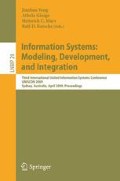Abstract
This paper introduces modeling methodologies to computer forensics to provide formalism and structured approach to computer forensics activities. It studies how to use UML diagrams to model and visualize various aspects of a computer forensics system. It first applies UML to model the basic components of a computer forensic process and their relationships. It then uses UML to further visualize the activities carried out for each component. The formal graphical model provides a well-defined and straightforward semantics to the computer forensics process making it easier to understand by various parties involved.
Access this chapter
Tax calculation will be finalised at checkout
Purchases are for personal use only
Preview
Unable to display preview. Download preview PDF.
References
Pollitt, M.M.: An Ad Hoc Review of Digital Forensic Models. In: The Second international Workshop on Systematic Approaches to Digital Forensic Engineering, pp. 43–54. IEEE Computer Society, Washington (2007)
Pollitt, M.: Computer Forensics: an Approach to Evidence in Cyberspace. In: Proceedings of the National Information Systems Security Conference, Baltimore, MD, pp. 487–491 (1995)
Palmer, G.: A Road Map for Digital Forensics Research, Utica, NY, Technical report DTR-T001-0 (2001)
Reith, M., Carr, C., Gunsch, G.: An Examination of Digital Forensic Models. IJDE 1(3), 1–12 (2002)
Carrier, B., Spafford, E.: Getting Physical with the Digital Investigation Process. International Journal of Digital Evidence 2(2) (2003)
Beebe, N., Clark, J.: A Hierarchical, Objectives-Based Framework for the Digital Investigations Process. Digital Investigation 2(2), 146–166 (2005)
Ieong, R.S.C.: FORZA - Digital Forensics Investigation Framework that Incorporate Legal Issues. Digital Investigation 3(suppl.1), 29–36 (2006)
Bogen, A.C., Dampier, D.A.: Unifying Computer Forensics Modeling Approaches: a Software Engineering Perspective. In: The First International Workshop on Systematic Approaches to Digital Forensic Engineering (2005)
Carroll, O.L., Brannon, S.K., Song, T.: Computer forensics: digital forensic analysis methodology. Computer Forensics 56(1), 1–8 (2008)
Unhelkar, B.: Practical Object Oriented Analysis. Thomson (2003)
ISO/IEC TR 18044, Information security incident management, ISO (the International Organization for Standardization) and IEC (the International Electrotechnical Commission) (2004)
Author information
Authors and Affiliations
Editor information
Editors and Affiliations
Rights and permissions
Copyright information
© 2009 Springer-Verlag Berlin Heidelberg
About this paper
Cite this paper
Ruan, C., Huebner, E. (2009). Formalizing Computer Forensics Process with UML. In: Yang, J., Ginige, A., Mayr, H.C., Kutsche, RD. (eds) Information Systems: Modeling, Development, and Integration. UNISCON 2009. Lecture Notes in Business Information Processing, vol 20. Springer, Berlin, Heidelberg. https://doi.org/10.1007/978-3-642-01112-2_19
Download citation
DOI: https://doi.org/10.1007/978-3-642-01112-2_19
Publisher Name: Springer, Berlin, Heidelberg
Print ISBN: 978-3-642-01111-5
Online ISBN: 978-3-642-01112-2
eBook Packages: Computer ScienceComputer Science (R0)

